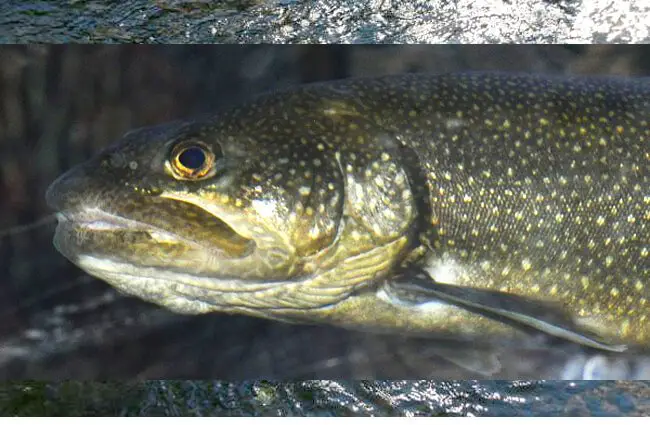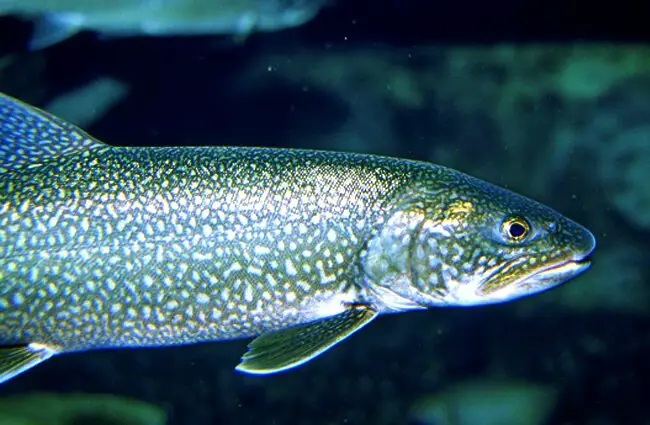The Majestic Lake Trout: A Deep Dive into North America’s Native Fish
The lake trout, Salvelinus namaycush, is a fascinating and ecologically important fish native to the cold, clear waters of North America. Often mistaken for a true trout, it is actually a member of the char family, a group of salmonids renowned for their resilience and adaptability. This comprehensive guide explores every facet of the lake trout’s life, from its evolutionary history and habitat to its role in the ecosystem and its interactions with humans.
![Closeup of a Lake Trout under water Photo by: Engbretson Eric, U.S. Fish and Wildlife Service [Public domain]](https://animals.net/wp-content/uploads/2020/01/Lake-Trout-3-650x425.jpg)
Origins and Evolution
The story of the lake trout stretches back to the Pleistocene epoch, the last glacial period. As glaciers advanced and retreated, they carved out the deep, cold lakes that would become the lake trout’s primary habitat. The species is believed to have evolved from ancestral char that were isolated in these glacial lakes. This isolation fostered genetic divergence, ultimately leading to the distinct characteristics we see in the modern lake trout. Interestingly, lake trout exhibit considerable genetic variation across their range, suggesting a complex history of population fragmentation and reconnection.
Habitat and Distribution
Lake trout are primarily found in large, deep lakes with cold, oxygen-rich waters. They prefer temperatures between 35 and 55 degrees Fahrenheit (2 to 13 degrees Celsius). They are native to many lakes across North America, including the western United States and Canada, and have been introduced to some lakes in Europe and Asia. Their distribution is largely dictated by water temperature and oxygen levels. They are often found in the deepest parts of lakes, where temperatures remain consistently cold throughout the year.
Physical Characteristics
Lake trout are easily recognized by their elongated body, relatively small scales, and distinctive spotting pattern. Their coloration can vary depending on their age and the clarity of the water, but they generally exhibit a dark olive or brown back and silvery sides with light spots. A notable characteristic is the presence of light spots and often red or pink spots along their sides and a pale, creamy underside. Mature individuals can reach impressive sizes, exceeding 30 inches in length and weighing over 30 pounds. They possess a large mouth with strong teeth, adapted for capturing and holding prey.

Diet and Feeding Habits
Lake trout are opportunistic predators with a varied diet. Young lake trout primarily feed on invertebrates, such as zooplankton and insect larvae. As they grow, they shift to a diet of fish, including smaller trout, whitefish, herring, and even other lake trout. They are ambush predators, relying on stealth and speed to capture their prey. They also actively forage in open water, tracking schools of fish. Lake trout have a well-developed sense of smell, which they use to locate prey in murky waters.
Reproduction and Life Cycle
Lake trout typically spawn in the fall, from September to November, in shallow, rocky areas of lakes. Females release thousands of eggs, which are fertilized by males. The eggs incubate over the winter, hatching in the spring. Young lake trout, called fry, initially feed on zooplankton. As they grow, they become piscivorous, feeding on small fish. Lake trout reach sexual maturity relatively late in life, typically between 5 and 7 years of age. They can live for several decades, with some individuals exceeding 50 years of age.
Ecological Role and Interactions
Lake trout play a crucial role in maintaining the health of aquatic ecosystems. As apex predators, they help regulate populations of other fish species. Their presence can also influence the distribution and abundance of prey species. Lake trout compete with other predators, such as walleye and pike, for food and habitat. They are also preyed upon by larger fish, such as muskellunge and occasionally birds of prey. Furthermore, lake trout contribute to nutrient cycling by excreting waste products and decomposing organic matter.
![Fresh-caught Lake Trout Photo by: U.S. Fish and Wildlife Service [Public domain]](https://animals.net/wp-content/uploads/2020/01/Lake-Trout-4-650x425.jpg)
Lake Trout and Humans
Lake trout have been a valuable food source for humans for centuries. They are also a popular sport fish, attracting anglers from around the world. However, human activities have had a significant impact on lake trout populations. Overfishing, habitat degradation, and the introduction of invasive species have all contributed to declines in some areas. Conservation efforts, such as fishing regulations and habitat restoration, are essential to ensure the long-term sustainability of lake trout populations.
Conservation Status and Threats
While lake trout are not currently listed as endangered or threatened, many populations are facing challenges. Climate change is a major threat, as rising water temperatures can reduce suitable habitat and increase stress on fish. Invasive species, such as non‑native trout and salmon, can outcompete native lake trout and disrupt food webs. Pollution and habitat degradation also pose significant threats. Effective conservation strategies require a holistic approach that addresses these multiple stressors.
Lake Trout in Captivity
Maintaining lake trout in captivity requires careful attention to their specific needs. Large tanks with cold, highly oxygenated water are essential. Providing a varied diet of fish and invertebrates is crucial for their health. Simulating natural conditions, such as seasonal temperature fluctuations and light cycles, can help reduce stress. Regular monitoring of water quality and fish health is essential. Avoid overcrowding, as this can increase the risk of disease. It is important to remember that lake trout are adapted to a cold‑water environment and may not thrive in warmer temperatures.
![Fish hatchery receiving a million lake trout eggs Photo by: U.S. Fish and Wildlife Service Northeast Region [Public domain]](https://animals.net/wp-content/uploads/2020/01/Lake-Trout-2-650x425.jpg)
Interesting Facts
- Lake trout can live for over 50 years.
- They are known as “mackinaw” in some parts of the Great Lakes.
- Lake trout can thrive in very deep, cold lakes, sometimes exceeding 600 feet.
- They are relatively slow‑growing, taking several years to reach maturity.
- Lake trout exhibit a unique spawning behavior called “rafting,” where several females deposit their eggs on the same spawning site.

Conclusion
The lake trout is a remarkable fish with a rich evolutionary history and an important ecological role. Its resilience and adaptability have allowed it to thrive in some of the coldest and deepest lakes in North America. However, this magnificent species faces numerous challenges in the 21st century. Through continued research, conservation efforts, and responsible management, we can ensure that future generations will have the opportunity to experience the beauty and wonder of the lake trout.

![Red Angus Closeup of a beautiful Red Angus cowPhoto by: U.S. Department of Agriculture [pubic domain]https://creativecommons.org/licenses/by/2.0/](https://animals.net/wp-content/uploads/2020/03/Red-Angus-4-238x178.jpg)




![Red Angus Closeup of a beautiful Red Angus cowPhoto by: U.S. Department of Agriculture [pubic domain]https://creativecommons.org/licenses/by/2.0/](https://animals.net/wp-content/uploads/2020/03/Red-Angus-4-100x75.jpg)

